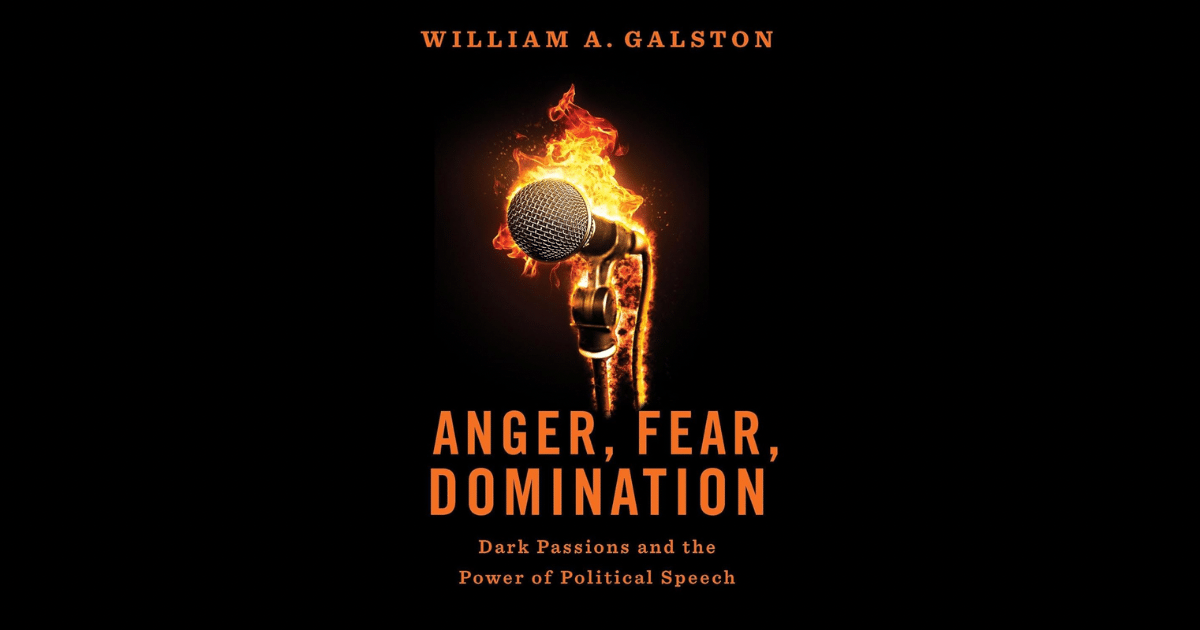William A. Galston’s Anger, Fear, Domination: Dark Passions and the Power of Political Speech illustrates a core problem within a political system that relies upon public consent. “Democracy’s defenders cannot defeat its enemies without understanding the enduring power of the passion to which they appeal—and how best to blunt this appeal.”(2) In an ideal world, a rational public discourse would consider the facts in a thoughtful, logical process.
However, as we all know, Pollyanna is not alive or well in contemporary America
What then is the solution to a problem dominated by public passions and leaders intent on manipulating them? Galston recommends “the improvement, not the replacement of liberal democracy.” (10) More specifically, the author suggests that “realism about the dark side of the human soul does not rule out an aspirational liberal politics.” (37)
In practice, this is an extremely difficult needle to thread.
Galston starts with a sharp critique of liberalism. At points, liberal belief suffers from self-created blinders. He counsels the reader to understand that: “Our commitment to liberal democracy must not be entangled with faith in the inevitability of progress.”(22) Too often, liberals prioritize economic growth as the main yardstick for progress, while losing track of equally, if not more importantly, measurements of social fulfillment. This blind spot brought to mind Thomas Frank’s 2004 book What’s the Matter with Kansas, which argued that citizens in Kansas – once a stronghold for progressive populist social movements – now vote against their own best interests when they support anti-elite conservatives and the reactionary culture war issues they wrap themselves in. However, dismissing the cultural underpinnings of conservative discontent, as Hillary Clinton did with her “basket of deplorables” remark in 2016, simply amplifies the problem by illustrating the profound gap between a fractured, restive public –with many legitimate grievances—and political leaders who willfully ignore them.(120) In his 2017 book, Insane Clown President, Matt Taibbi’s scathing commentary about the Clinton campaign’s “Mannequin Challenge” video is a perfect snapshot of the moment:
As a metaphor for an overconfident and incompetent ruling class that was ten miles up its own backside when it should have been listening to the anger percolating in the population, the “Mannequin Challenge” is probably unsurpassable. Here was a planeload of effete politicos making a goofball video when they should have been frantically bailing water to stave off maybe the most disastrous loss in the history of American presidential politics.(xix)
In order to understand the foundation of this problem, Galston indulges in a lengthy examination of the definitions of “dark passions” at work within the public discourse. He offers an extensive catalogue of the types of fear; fear of death, of disaster, of the loss of physical and mental acuity, of a loss of social ties, of dishonor, failure, embarrassment, of the future, or threats to a way of life. (78-83)
Importantly, the author makes the distinction between “productive and counter-productive fear.” (70) In his classic work on the American condition, Alexis de Tocqueville encouraged a life recognizing “salutary fear which makes men keep watch and ward for freedom, and not with that flabby, idle terror which makes men’s hearts sink and enervates them.”(68)
It is in this distinction that the book offers a possible solution to what ails the country. To illustrate his point, Galston borrows from the past. FDR’s 1933 fireside chat on the bank crisis is a masterclass on balancing fear with a common purpose for action. Roosevelt spoke about citizens being instrumental to effective public policy. Washington could regulate banks, but the average person had to trust their relationship with law makers to make deposits again. FDR did not promise an easy path, but he did make sure that Americans understood cooperation and collective action were essential. (128-131)
Years after the Great Depression was over, Richard Hofstadter wrote about the basic qualities of “a decent society” in 1968. His treatment deserves quoting at length:
Comity exists in a society to the degree that those enlisted in its contending interests have a basic minimal regard for each other: one party or interest seeks the defeat of an opposing interest on matters of policy, but at the same time seeks to avoid crushing the opposition, denying the legitimacy of its existence or values, or inflicting upon it extreme and gratuitous humiliations beyond the substance of the gains that are being sought. The basic humanity is not forgotten; civility is not abandoned; the sense that a community life must be carried on after the acerbic issues of the moment have been fought over and won is seldom far out of sight; an awareness that the opposition will someday be the government is always present.(124)
Robert F. Kennedy applied this principle that same year at a campaign event in Indianapolis when news of Martin Luther King’s death reached the gathering. Kennedy treated the crisis like a responsible leader. He acknowledged that members of his audience might be overwhelmed “with bitterness, with hatred, and … a desire for revenge.”(131) He invoked King’s memory and urged the people assembled to peacefully return home. His own personal experience with a brother’s life cut short gave his empathy agency. Indianapolis avoided the havoc that engulfed the rest of the country.
READ: President Trump’s Ft. Bragg Speech Was Dangerous and Disturbing in How it Politicized the Military
Kennedy captured lightning in a bottle in 1968. Subsequent history has proven how rarely the appeal to the “better angels of our nature,” as Abraham Lincoln once famously said, actually works. Persuasion is limited by a long list of factors.(108-109) Without a shared frame of reference, consensus flounders.(114) The sometimes deliberate ignorance of facts and the absence of expertise, as we learned during COVID and since the pandemic, undercuts official authority when we need it most. Public impatience, and the appeal of short-term solutions, too often circumvent robust policy requiring diligence and significant commitments.
Perhaps the most durable obstacle to progress, something that America has wrestled with since its creation, lies in reconciling the principle of individualism with the need for collective social stability.
It is here that Anger, Fear, Domination, understandably falls a bit short. While it provides detailed and useful definitions and an examination of the problem affecting the country, a viable prescription is elusive. “Realism demands more than a narrow focus on achieving political order within which individuals can pursue their self-interest.” (35)
This is true, but what is the solution? How can we foster a “full awareness of the threat the darker side of human nature will always pose.”? (135)
I think the answer is right in front of us.
As of this writing, we are just weeks removed from a peaceful election where the people voted on a host of issues from judicial retention to the composition of local school boards. The people spoke. And it is important to understand that the public is capable of forming its own conclusions about the constant “darker side of human nature.”
Time will tell. But there is hope out there.







